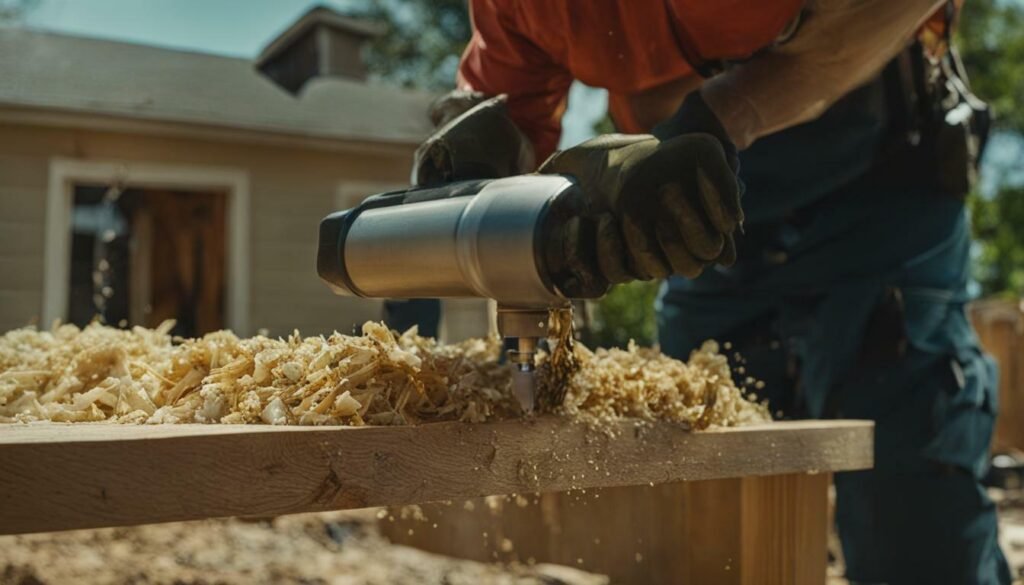If you’re wondering whether drilling is necessary for termite treatment, you’ve come to the right place. Discovering the most effective techniques and understanding the importance of drilling can help ensure your home is termite-free.
When it comes to termite treatment, drilling is indeed necessary for effective eradication. Subterranean termites reside in the soil surrounding and beneath homes, making it crucial to reach the source of the infestation. By drilling holes into the concrete foundation, a specialized termiticide can be injected directly into the soil, targeting the termites where they live.
Key Takeaways:
- Drilling is necessary for termite treatment to reach the source of the infestation.
- Subterranean termites require targeted treatment in the soil where they live.
- Rodding and trenching methods are used alongside drilling to create a protective barrier around the property.
- Professional termite control specialists ensure safe and effective drilling processes.
- Understanding the importance of drilling can help keep your home termite-free.
Understanding Termite Control Methods
Before we dive into the specifics of drilling for termite treatment, let’s take a moment to explore the various methods used to control and exterminate termites. These destructive pests can cause significant damage to homes and structures, making effective termite control crucial.
One commonly used termite control method is drilling. This technique involves creating holes in the concrete foundation to inject termiticide directly into the soil where termites live. By reaching the source of the infestation, drilling ensures that the treatment effectively eliminates the termites and prevents further damage.
Rodding and trenching are also effective methods used in conjunction with drilling. These techniques help create a protective barrier around the property, preventing termites from accessing the structure. Rodding involves inserting termite control products into the soil around the foundation, while trenching requires digging a trench around the perimeter and treating it with termiticide.
It’s important to note that drilling holes in the concrete foundation is a specialized task that should be carried out by professional termite control specialists. These experts have the knowledge and experience to ensure that the drilling process is done safely and effectively, minimizing any potential risks or damage to the structure.
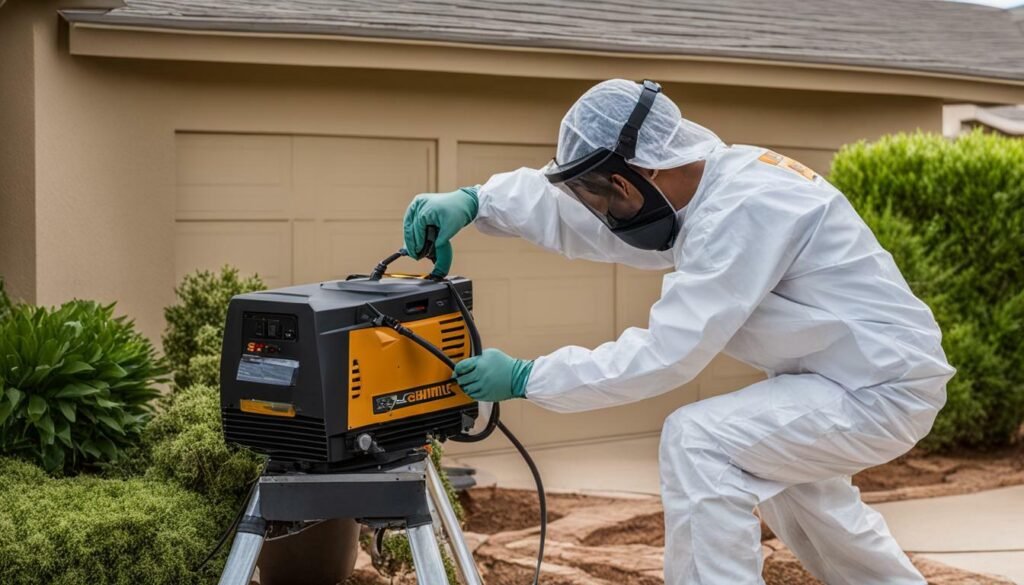

The Role of Drilling in Termite Treatment
When it comes to effectively eliminating termites, drilling plays a vital role in reaching the heart of the problem. Subterranean termites, the most common type found in homes, live in soil beneath and around properties. These destructive pests can cause significant damage if left untreated, making it crucial to implement effective termite control methods.
Drilling holes in the concrete foundation is a necessary step in termite treatment as it allows termiticide to be injected directly into the soil where termites reside. This targeted approach ensures that the pesticide reaches the source of the infestation, effectively eradicating the termites and preventing further damage to the property.
In addition to drilling, rodding and trenching methods are often employed to complement the treatment process. These techniques involve creating a protective barrier around the property to prevent termites from accessing the structure. By combining drilling with these methods, termite control specialists can effectively eliminate existing infestations and provide long-term protection against future termite damage.
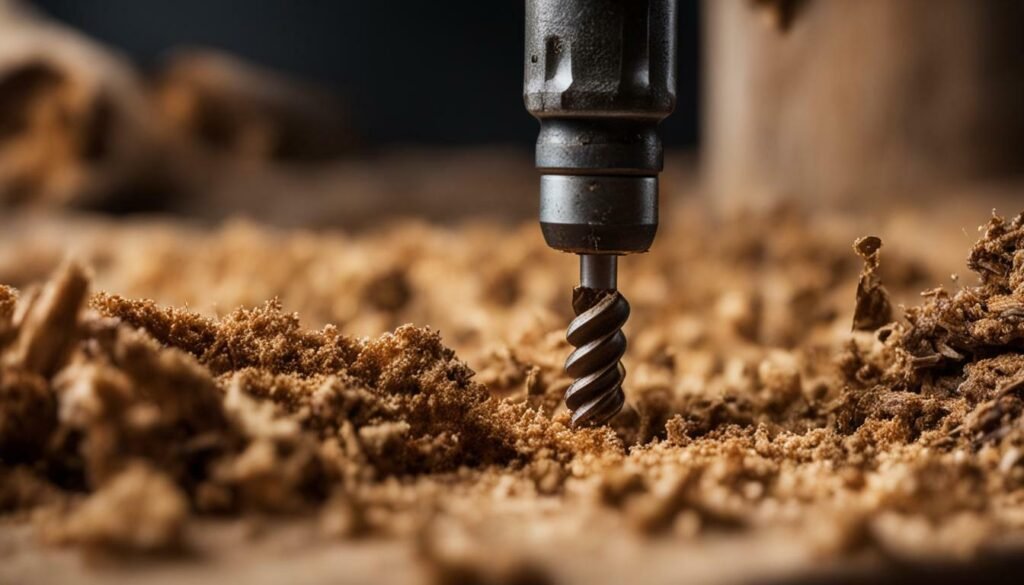

Drilling Process in Termite Treatment
The drilling process for termite treatment is conducted by professional pest control specialists who have the expertise and knowledge to handle it safely and effectively. They use specialized equipment to drill precise holes into the concrete foundation, ensuring minimal disruption to the structure.
Once the holes are drilled, the termiticide is injected directly into the soil, targeting the area where the termites dwell. The termiticide creates a barrier that prevents termites from entering the property, effectively eradicating the infestation and protecting the structure from further damage.
It is important to note that drilling for termite treatment should only be carried out by trained professionals. They have the necessary skills to identify the optimal locations for drilling and ensure that the process is done safely, minimizing any potential risks or damage to the property.
| Benefits of Drilling in Termite Treatment |
|---|
| 1. Effective elimination of termites by reaching the source of the infestation. |
| 2. Long-term protection against future termite damage through the creation of a barrier. |
| 3. Safe and precise drilling process conducted by professional termite control specialists. |
In summary, drilling is a necessary component of termite treatment as it allows for targeted application of termiticide, effectively reaching the source of the infestation. When combined with rodding and trenching methods, drilling creates a comprehensive termite control strategy that protects the property from current and future termite damage. It is crucial to rely on professional termite control specialists who have the expertise to handle drilling and ensure its safe and effective execution.
The Process of Drilling for Termite Treatment
Let’s take a closer look at the process of drilling for termite treatment and how it ensures thorough and effective elimination of termites. When it comes to termite control, drilling holes in the concrete foundation is a crucial step in reaching the source of the infestation. Subterranean termites, which are the most common type of termites found in homes, live in the soil beneath and around the property. By drilling holes into the foundation, professional termite control specialists can inject a termiticide directly into the soil where these destructive pests reside.
Drilling allows for targeted application of termiticide, ensuring that it reaches the termites’ nesting areas deep within the soil. The termiticide creates a protective barrier that prevents termites from entering or exiting the property. This method is highly effective in eliminating existing termite colonies and preventing new infestations.
Alongside drilling, rodding and trenching techniques are often employed to create a comprehensive termite control plan. These complementary methods further enhance the protective barrier around the property, preventing termites from accessing the structure. Rodding involves inserting rods treated with termiticide into the ground around the foundation, while trenching involves digging a trench around the property and treating it with termiticide. Together, these methods provide added protection against termite infestations.
| Benefits of Drilling for Termite Treatment: |
|---|
| 1. Targets termites at the source of infestation |
| 2. Creates a barrier to prevent termite entry and exit |
| 3. Highly effective in eliminating current and preventing future infestations |
| 4. Complementary techniques like rodding and trenching enhance protection |
Drilling is a necessary component of termite treatment as it provides a direct and effective way of reaching the subterranean termites’ nesting areas. By utilizing professional termite control specialists, you can ensure that drilling is done safely and effectively, giving you peace of mind in protecting your property from these destructive pests.
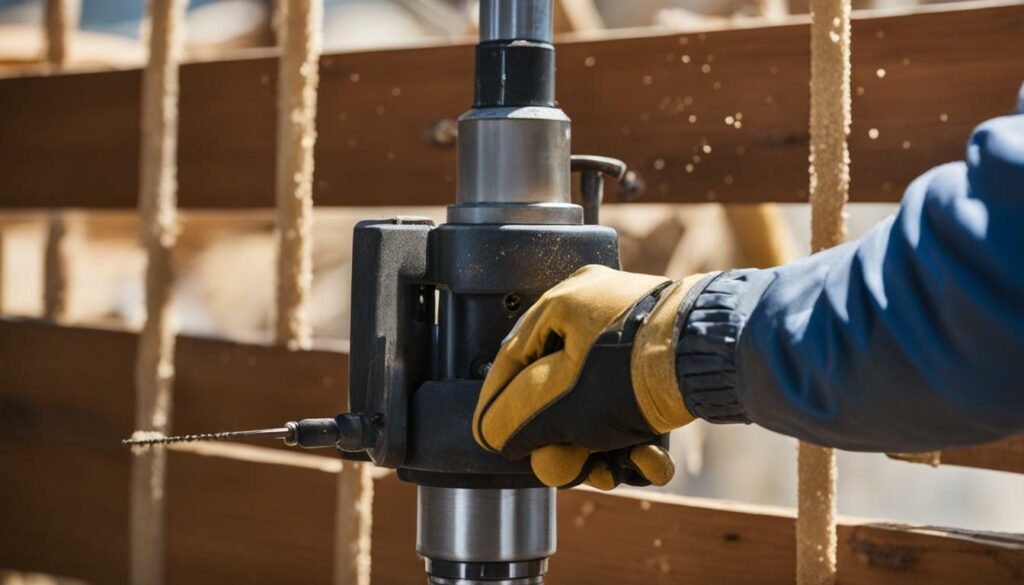

As with any termite treatment method, it’s important to consult with a professional to assess the severity of the infestation and determine the most appropriate course of action. They can conduct a thorough inspection and recommend a comprehensive termite control plan that may include drilling, rodding, trenching, or other techniques tailored to your specific needs.
Remember, effective termite treatment goes beyond eliminating the current infestation; it also involves implementing prevention strategies to safeguard your property from future termite problems. Regular inspections, moisture control, and removing potential food sources are all essential in maintaining a termite-free environment.
Rodding and Trenching as Complementary Techniques
In addition to drilling, termite control specialists often utilize rodding and trenching techniques to provide comprehensive protection against termite infestations. These methods work in conjunction with drilling, creating a multi-layered defense system that prevents termites from entering and damaging your property.
Rodding involves inserting treated rods into the ground around the perimeter of your home. These rods release termiticide, creating a barrier that repels and kills termites. This technique is especially useful in areas where drilling may not be possible, such as near pipes or utility lines. Additionally, rodding can be an effective strategy for targeting specific areas of infestation or preventing termite activity in hard-to-reach places.
Trenching, on the other hand, involves digging narrow trenches along the foundation of the building. The trenches are then treated with termiticide, creating a barrier that prevents termites from accessing your home. This method is particularly effective for properties with a significant termite risk, as it provides a continuous protection zone. Trenching can also be combined with drilling to ensure maximum coverage and effectiveness in termite prevention.
By combining these techniques with drilling, termite control specialists are able to create a thorough and highly effective termite prevention strategy. This multi-pronged approach ensures that termites are not only eliminated from your property but also prevented from reinfesting in the future. It is important to rely on professional termite control specialists who have the expertise and knowledge to implement these techniques safely and effectively.
Comprehensive Protection Against Termites
| Method | Description |
|---|---|
| Drilling | Creates holes in the concrete foundation to inject termiticide into the soil where termites reside. |
| Rodding | Inserts treated rods into the ground to release termiticide, creating a protective barrier against termites. |
| Trenching | Digs narrow trenches along the foundation and treats them with termiticide to prevent termite access. |
Utilizing a combination of drilling, rodding, and trenching techniques ensures comprehensive protection against termite infestations. These methods target termites at various stages of their life cycle and disrupt their ability to infiltrate your property. By creating a multi-layered defense system, termite control specialists can effectively eliminate existing infestations and prevent future ones, safeguarding your home and providing you with peace of mind.


Non-Drilling Termite Treatment Options
Although drilling is the preferred method for termite treatment, there are alternative options available for those who prefer non-drilling approaches. These methods can be effective in controlling termite infestations, particularly when used in combination with preventive measures. Here are some non-drilling termite treatment options to consider:
1. Termite Baiting Systems
Termite baiting systems are an alternative to drilling-based treatment methods. These systems utilize bait stations strategically placed around your property to attract termites. The bait contains substances that are lethal to termites, which they then carry back to their colony, effectively eliminating the entire termite population. Termite baiting systems are often used as part of a comprehensive termite control plan and require ongoing monitoring and maintenance.
2. Foam Treatments
Foam treatments are another non-drilling option for termite control. A specially formulated foam is injected into termite galleries and other infested areas, expanding to fill the voids and reaching the termites hiding inside. This method can be particularly effective for localized termite infestations and can provide immediate results. Foam treatments can also be used as a preventive measure in areas where termite activity is suspected.
3. Heat Treatments
Heat treatments involve raising the temperature of the infested area to a level that is lethal to termites. This method is often used for localized infestations in specific areas of the property. Heat treatments can penetrate difficult-to-reach areas and provide a non-chemical alternative for termite control. However, it is important to note that heat treatments may not be suitable for all situations and may require specialized equipment and expertise.
While non-drilling termite treatments can be effective, it is essential to consult with a professional termite control specialist to determine the most suitable approach for your specific situation. They can assess the extent of the infestation, identify the most effective treatment methods, and ensure that the treatment is carried out safely and effectively.
| Non-Drilling Termite Treatment Options | Pros | Cons |
|---|---|---|
| Termite Baiting Systems | – Effective in eliminating entire termite colonies – Can be part of a comprehensive termite control plan |
– Requires ongoing monitoring and maintenance – May take time to achieve full eradication |
| Foam Treatments | – Immediate results for localized infestations – Can be used as a preventive measure |
– May not be suitable for extensive infestations – Limited coverage area |
| Heat Treatments | – Non-chemical alternative – Penetrates difficult-to-reach areas |
– May require specialized equipment – Not suitable for all situations |
Remember, termite control is not a one-size-fits-all approach. It is crucial to work with a professional termite control specialist who can assess your specific situation and recommend the most effective treatment options. Whether you choose drilling or non-drilling methods, the ultimate goal is to protect your property from the damaging effects of termites.


The Effectiveness of Termite Treatment Without Drilling
While non-drilling termite treatment options may be appealing, it’s essential to evaluate their effectiveness compared to traditional drilling methods. Drilling is a crucial step in termite treatment as it allows the termiticide to be injected directly into the soil where the termites live. By reaching the source of the infestation, drilling ensures that the termite control solution can effectively eradicate the pests.
However, there are alternative termite treatment methods that do not involve drilling. These methods include baiting systems and foaming applications, which may be less invasive and disruptive to your property. Baiting systems work by attracting termites with a toxic substance, which they consume and take back to their colony, effectively eliminating the infestation. Foaming applications, on the other hand, involve injecting foam termiticide directly into termite galleries to eradicate the pests.
It’s important to note that while non-drilling methods may seem advantageous, they may not be as effective in eliminating termite infestations compared to drilling-based methods. This is because drilling allows the termiticide to directly reach the heart of the termite colony, ensuring comprehensive eradication. Alternative methods may be more suitable for smaller, localized infestations or as preventive measures.
When considering termite treatment options, it is recommended to consult with a professional termite control specialist. They have the expertise to assess the extent of the infestation and determine the most effective treatment method for your specific situation. Professional termite control specialists ensure that drilling or alternative methods are carried out safely and effectively, providing long-lasting termite protection for your property.
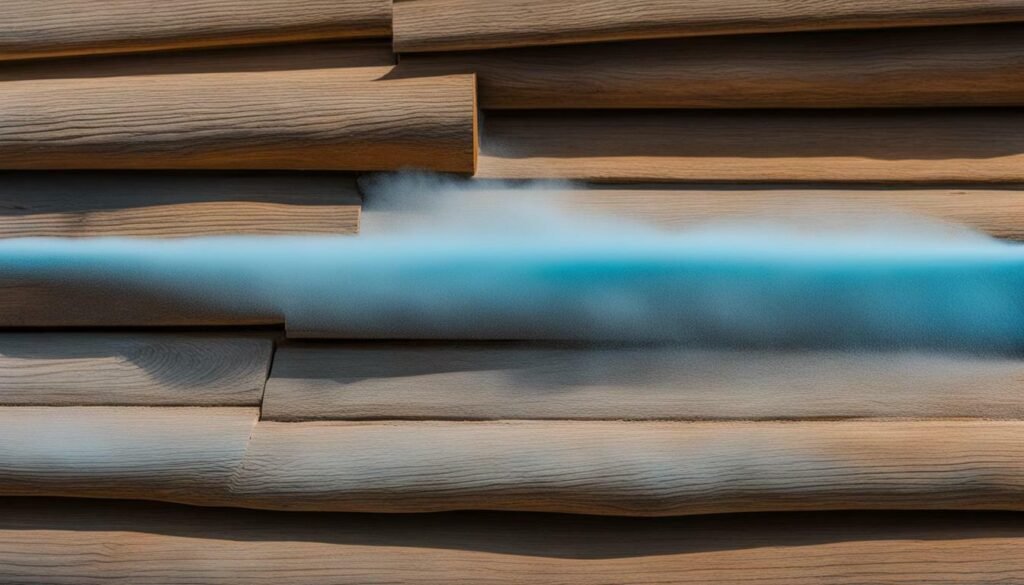

| Method | Effectiveness | Advantages | Disadvantages |
|---|---|---|---|
| Drilling | Highly effective, reaches source of infestation | Comprehensive eradication | Can be disruptive to property, requires professional expertise |
| Baiting systems | Varies depending on product and infestation | Minimally invasive, long-term protection | May take longer to eliminate infestation, ongoing monitoring required |
| Foaming applications | Effective for localized infestations | Less invasive, targets termite galleries directly | May not reach entire colony, multiple treatments may be necessary |
Ensuring Termite Prevention Strategies
Prevention is key when it comes to termite control, and understanding and implementing effective termite prevention strategies can significantly reduce the need for treatment, including drilling. By taking proactive measures to make your property less attractive to termites, you can minimize the risk of infestation and potential damage to your home.
One important prevention strategy is to maintain proper drainage around your property. Termites thrive in moist environments, so ensuring that water drains away from your foundation can help deter them. Regularly clean out gutters and downspouts to prevent water from pooling near your home. Additionally, ensuring that your sprinkler system is not spraying water directly onto your foundation can also help prevent moisture buildup.
Another crucial step in termite prevention is removing or minimizing wood-to-soil contact around your property. Termites feed on wood, so eliminating their access to it is essential. Make sure firewood, lumber, and other wooden materials are stored at least 20 feet away from your home and raised off the ground. Avoid using mulch against your foundation, as it can create an attractive environment for termites.
Termite Prevention Strategies
- Maintain proper drainage around your property to prevent moisture buildup.
- Remove or minimize wood-to-soil contact by storing wooden materials away from your home and raised off the ground.
- Avoid using mulch against your foundation.
- Regularly inspect and seal any cracks or openings in your home’s foundation, walls, and roof.
- Keep your property well-ventilated to reduce moisture levels.
- Schedule regular termite inspections with a professional pest control company.
Implementing these termite prevention strategies can go a long way in safeguarding your home from termite infestations. However, it’s important to note that prevention measures may not guarantee absolute protection. In some cases, drilling may still be necessary to address existing termite infestations or establish a protective barrier around your property.
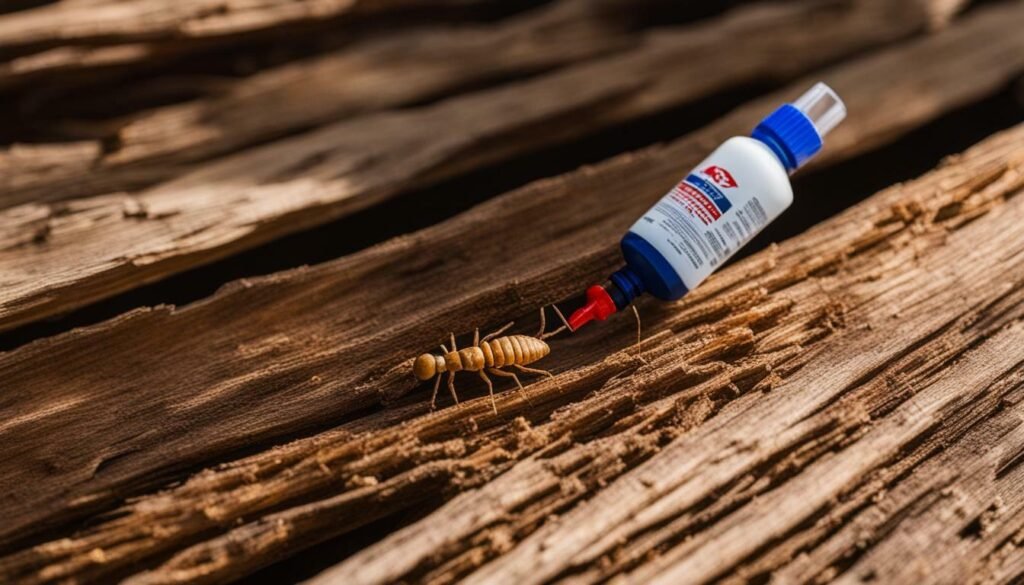

| Termite Prevention Strategies | Effectiveness | Key Points |
|---|---|---|
| Maintain proper drainage | High | Prevents moisture buildup, reducing termite attraction. |
| Remove wood-to-soil contact | High | Eliminates access to food source, discouraging termites. |
| Avoid using mulch against the foundation | Moderate | Reduces termite-friendly environment near the home. |
| Inspect and seal cracks/openings | Moderate | Prevents termite entry points into the home. |
| Ensure proper ventilation | Moderate | Reduces moisture levels, deterring termites. |
| Schedule regular inspections | High | Professional evaluation and early detection of termites. |
By combining effective termite prevention strategies with regular inspections and the expertise of professional termite control specialists, you can minimize the risks associated with termites and protect your property for years to come.
Weighing Drilling vs Non-drilling Termite Treatment
Choosing between drilling and non-drilling termite treatment methods can be a significant decision, so let’s weigh the pros and cons of each approach. Drilling is a commonly used technique in termite control, as it allows the termiticide to be injected directly into the soil where subterranean termites live. By reaching the source of the infestation, drilling ensures effective elimination of the termites and prevents further damage to your property.
Non-drilling termite treatment methods, on the other hand, offer some advantages that may be appealing to certain homeowners. These methods often involve baiting systems that lure termites with a toxic substance, which they then carry back to the colony. This can be a less invasive option compared to drilling, as it does not require any holes to be made in your concrete foundation.
However, it’s important to consider the limitations of non-drilling methods. While they can be effective in eliminating termites in localized areas, they may not provide the same comprehensive protection as drilling. Without reaching the source of the infestation, there is a risk that termites may remain hidden and continue to cause damage over time. Additionally, non-drilling methods may require ongoing monitoring and maintenance to ensure their continued effectiveness.
| Drilling | Non-drilling |
|---|---|
| Effective in reaching the source of the infestation | May not provide comprehensive protection |
| Prevents further damage to your property | May require ongoing monitoring and maintenance |
| Usually performed by professional termite control specialists | Can be a less invasive option |
Ultimately, the decision between drilling and non-drilling termite treatment methods depends on your specific situation and preferences. If you’re dealing with a severe termite infestation or want to ensure comprehensive protection for your property, drilling may be the best choice. On the other hand, if you prefer a less invasive approach and are willing to invest in ongoing monitoring, non-drilling methods may be worth considering. Consulting with a professional termite control specialist can help you make an informed decision based on your unique needs.


Professional Termite Control Specialists and Drilling
When it comes to drilling and other termite control methods, it’s crucial to trust the expertise of professional specialists who can ensure the process is done safely and effectively. Drilling is a necessary step in termite treatment, as it allows the termiticide to be injected into the soil where subterranean termites live. These pests often reside in the soil beneath and around homes, making it challenging to reach them without drilling holes into the concrete foundation.
Professional termite control specialists have the knowledge and experience to determine the optimal locations for drilling and identify the areas that require treatment. They are trained to handle the drilling equipment safely and effectively, minimizing any potential risks. By relying on experts, you can have peace of mind knowing that the drilling process is being carried out by professionals who understand the intricacies of termite behavior and treatment techniques.
Additionally, professional termite control specialists use other methods in conjunction with drilling to create a comprehensive termite control plan. Rodding and trenching are often employed to create a protective barrier around the property, further enhancing the effectiveness of termite treatment. These complementary techniques help ensure that termites are effectively exterminated and prevented from reinfesting the property.
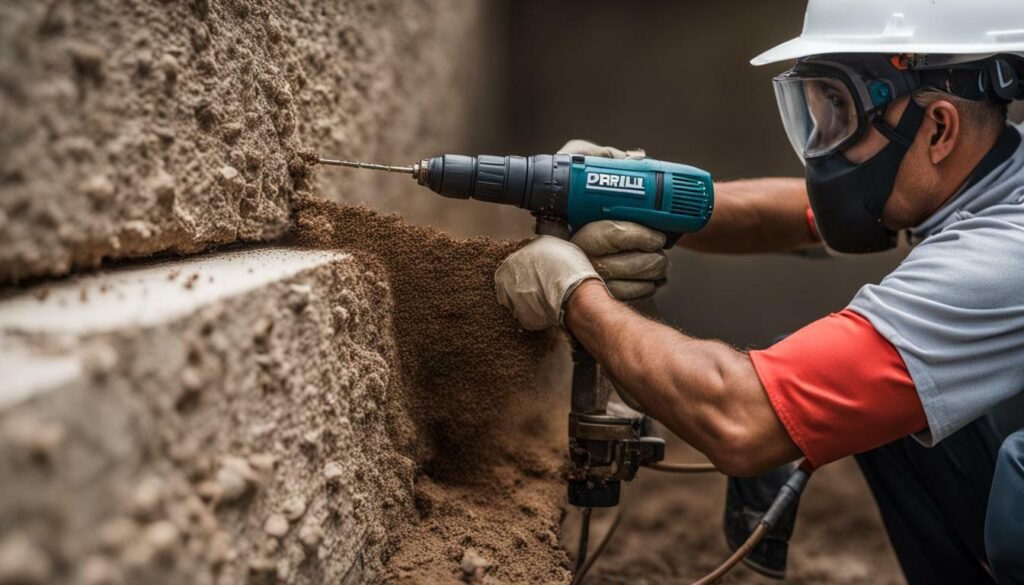

By engaging professional termite control specialists, you can benefit from their expertise in drilling and other termite treatment methods. They will not only carry out the necessary drilling but also provide tailored solutions based on the specific needs of your property. Remember, effective termite treatment requires a combination of drilling, rodent, and trenching techniques, all of which are best handled by experienced professionals.
Exploring Alternative Termite Treatment Methods
In addition to non-drilling options, there are alternative termite treatment methods available that can provide effective results, depending on the unique circumstances of your termite infestation. These alternatives offer viable solutions for those who prefer not to drill or have specific limitations that prevent drilling. Let’s take a closer look at some of these methods:
- Termite Bait Systems: Bait systems involve strategically placing termite bait stations around your property. The bait stations contain materials that attract termites, which then ingest the toxic bait and carry it back to their colony, effectively eliminating the entire termite population.
- Heat Treatment: Heat treatment involves raising the temperature within the infested area to a level that is lethal to termites. This method is particularly effective for localized infestations and can be used in combination with other treatment techniques.
- Electro-Gun Treatment: Electro-gun treatment utilizes a special device that emits a low-voltage electrical current to kill termites. The electrical current is directed into galleries and voids where termites are present, effectively eliminating the infestation.
While these alternative methods can be effective, it’s important to note that their suitability depends on various factors, including the severity of the infestation, the type of termite species present, and the unique characteristics of your property. Consulting with a professional termite control specialist is essential to determine the most appropriate treatment method for your specific situation.
Comparison of Termite Treatment Methods
It’s helpful to compare the different termite treatment methods to better understand their advantages and limitations:
| Method | Advantages | Limitations |
|---|---|---|
| Drilling | – Effective in reaching the source of infestation – Ensures thorough treatment – Can be used in combination with other techniques |
– Requires drilling into the concrete foundation – May cause temporary disruption |
| Termite Bait Systems | – Non-intrusive and no drilling required – Provides long-term control – Targets entire termite colony |
– Takes time for bait to be spread and eliminate the colony – Requires regular monitoring and maintenance |
| Heat Treatment | – Environmentally friendly and chemical-free – Targets localized infestations – Penetrates hard-to-reach areas |
– Requires specialized equipment and expertise – May not be suitable for all types of infestations |
| Electro-Gun Treatment | – Non-chemical solution – Targets specific areas without widespread treatment – Provides immediate results |
– Requires access to galleries and voids – Expertise needed for targeting termites accurately |
Remember, successful termite treatment involves a comprehensive approach that may combine different methods to ensure complete eradication and long-term prevention. Consulting with a professional termite control specialist will help determine the most effective treatment method for your specific termite infestation.


Conclusion
In conclusion, drilling is necessary for termite treatment to effectively eliminate termite infestations, particularly for subterranean termites. The process of drilling holes into the concrete foundation allows the termiticide to be injected into the soil where the termites live, reaching the source of the infestation. This is a crucial step in termite control and plays a significant role in eradicating termites from your property.
However, it’s important to note that non-drilling and alternative methods can also be considered depending on specific situations and preferences. These methods may include non-invasive treatments such as bait stations or heat treatments. While these methods may be suitable for certain scenarios, they may not offer the same level of effectiveness as drilling-based techniques.
When dealing with termite infestations, it’s always best to trust professional termite control specialists. They have the expertise and knowledge to determine the most appropriate treatment approach for your specific situation. Professional technicians ensure that drilling and other termite treatment methods are applied safely and effectively, minimizing any potential risks and maximizing the long-lasting termite-free protection of your property.
FAQ
Q: Is drilling necessary for termite treatment?
A: Yes, drilling is necessary for termite treatment to effectively reach the source of the infestation.
Q: Why is drilling necessary for termite treatment?
A: Drilling allows the termiticide to be injected into the soil where subterranean termites live, ensuring effective control of the infestation.
Q: How is drilling done for termite treatment?
A: Professional termite control specialists drill holes into the concrete foundation, following a step-by-step process to safely and effectively treat the termite infestation.
Q: What other techniques are used in conjunction with drilling for termite treatment?
A: Rodding and trenching methods are often used alongside drilling to create a protective barrier around the property, enhancing the effectiveness of termite control.
Q: Are there non-drilling termite treatment options available?
A: Yes, there are alternative termite treatment methods that do not involve drilling, although their effectiveness may vary depending on the extent of the infestation.
Q: How effective is termite treatment without drilling?
A: Termite treatment without drilling can be effective for certain situations, but drilling remains a crucial step in reaching the source of the infestation for more comprehensive control.
Q: What other termite prevention strategies should be considered?
A: Along with termite treatment, implementing preventative measures such as maintaining proper drainage, removing wood debris, and regular inspections can help prevent future termite infestations.
Q: What factors should be considered when choosing between drilling and non-drilling termite treatment?
A: Factors such as effectiveness, cost, and convenience should be weighed when deciding between drilling and non-drilling termite treatment methods.
Q: Why is it important to rely on professional termite control specialists for drilling and other termite treatment techniques?
A: Professional termite control specialists have the expertise and experience to safely and effectively perform drilling and other termite treatment techniques, ensuring the best possible results.
Q: Are there any additional alternative termite treatment methods worth exploring?
A: In addition to non-drilling options, there are other alternative termite treatment methods available, including heat treatments, baiting systems, and fumigation, which may be suitable for specific situations.
Source Links
- https://pestquit.in/why-do-pest-control-professionals-drill-holes-for-termite-treatment/amp/
- https://www.mightymitetermite.com/blog/termite-treatment-application-rodding-vs-drilling/
- https://upgradedhome.com/is-drilling-necessary-for-termite-treatment/
Your Expert in Animal Control and Extermination. Trust our experience for humane, effective pest management, protecting your property and ensuring peace of mind with Michael S.

